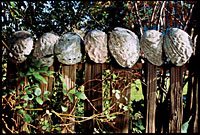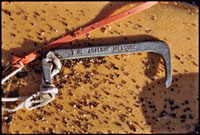|

|
|
Diving into California's last abalone fishery.
By Daniel Duane
(page 2 of 2)
 |
| A revered California pastime has taken its toll on a once abundant abalone fishery.
|
I'd awakened in San Francisco that morning before dawn, kissed my sleeping daughters, crossed the Golden Gate Bridge in the dark, and shot north up Highway 101, past the already-clogged southbound commute. Turning west on 116, through Petaluma and into Sonoma County farm country, I'd found my way to James's Sebastopol home, on a quiet rural lane. I'd first met him years before, when he was fresh out of the Navy SEALs, hurling himself at the professional triathlon circuit and starting an undergraduate degree at UC Santa Cruz. James was on the university's swim, cross-country, and bike teams simultaneously, completing all of the respective workouts despite being almost ten years older than most of his teammates. Even in the hyper-athletic world of the SEALs, James was known as a fitness nut, a guy who would finish his training for the day and then spend all his rec time working out.
James also had a great spirit, an easy laugh, and a friendly demeanor, and he was clearly more interested in having fun than in fighting war. He became a regular at the Ironman Triathlon and later, after he graduated, discovered yet another outlet for his frogman training: abalone diving. When James and his wife moved to Sebastopol, it became a consuming passion, and he even signed up as a part-time Sonoma Coast lifeguard, helping with body-recovery operations whenever an ab diver managed to drown. When private security companies started sending contractors to Iraq, paying enormous salaries to guys like James--ex-commandos from the special-operations community--he preferred to stay home with his wife and kids and make as much time for the water as possible.
In an attempt to stop the continuing decline of abalone numbers--due in part to the booming popularity of recreational diving and in part to a serious problem with poachers, who can sell their illegal booty for more than $100 a pound--state officials have instituted stronger rules for the Northern California fishery. No abalone under seven inches can be legally taken, in the hope that all sexually mature specimens will get a chance to reproduce--a critical issue given that no significant reproductive event has occurred in at least ten years, leaving the population dangerously devoid of younger members. Scuba gear is also outlawed, so that enormous reaches of habitat, below the depth range of free divers, can operate as de facto breeding sanctuaries. And game wardens routinely patrol the coast, checking licenses and punch cards. Poaching now carries stiff penalties: Poachers busted in San Francisco in 2004 faced a $40,000 fine and a year in county jail.
 |
| Using a measure to make sure abs are legal size can help juveniles reach reproductive age.
|
Abalone diving is also dangerous, even for those who don't take it to the same extremes James does. Three or four divers die every year off the Sonoma and Mendocino County coasts--including one the month before we went and two a few months earlier--a number vastly higher, for example, than the mortality rate for surfing, which draws many more participants to the same waters. Some simply drown, others get stuck in kelp and forget to release their weight belts, and still others get dashed against cliffs by high seas. But there's also the shark hazard that had me so freaked out. Ever since the 1960s, when commercial divers began using wetsuits, flippers, and scuba gear--mimicking seals in a way the earlier Japanese hard-hat divers never did--sharks have taken a big interest. Attacks were common enough, in fact, that divers began experimenting with protective cages, which they'd lower to the ocean floor while they worked, wearing Kevlar body armor to shield the large arteries in the legs, and carrying Glock 9mm pistols.
Free divers are no safer. In August 2004, for example, Randy Fry and Cliff Zimmerman were floating side by side off the Mendocino County coast. "He might have just dived," Zimmerman recalled. "I was looking down when I heard a whooshing sound and felt the water move, as if a boat went by. I turned to see what it was and saw the side of a big fish." Fry was nowhere in sight, the shark having apparently taken him under, and moments later, Zimmerman said, "everything turned red." The lifeguards who found the body, while searching in a boat, began hauling Fry toward them only to see his head separate from the torso and sink. ("You go get it," one lifeguard is rumored to have said to another. "No way," his colleague replied. "You get it.") Three weeks later, Fry's head washed ashore and was found by a beachcomber.
But despite all this, James feels compelled to make the experience even more challenging because he's like that. He never brings an abalone iron--essentially a stainless-steel shoehorn--preferring to loosen the mollusks by hand. If you so much as brush against an abalone, its foot muscles seize hard against the rock, making it impossible to remove with a pry bar. And because abalones are hemophiliacs, and an iron can cut one's foot, the iron can easily cause an abalone to bleed to death before a diver has confirmed that it's within the legal limit. But if you sneak up carefully, you can flick an abalone right off the rock before it knows what's hit it; that way, if you've taken one that's too small, you can place it back on the rock, press until it has a good grip, and rest assured that you haven't killed the thing. James also abides by an even stricter self-imposed size limit--nine inches, a genuine rarity for most abalone divers and yet commonplace for him. Most astounding of all, he rarely dives in less than 50 feet of water and often goes as deep as 80 feet, even in near-zero visibility, to places where abalones are still truly plentiful. Those depths challenge scuba divers; they're monumental for free divers. Tagging along with this guy, in other words, was both a great way to make sure I got an abalone and a daunting proposition.
Shooting downward with surprising speed--aided by that weight belt--I tried to focus not on the awful, impenetrable gloom but on the small field of green kelp around my eyes. Except that green grew darker and I got way too scared, and then I spun around and beat it to the surface.
"Good job," James said. "You did fine. Try not to move your arms too much. You want to conserve oxygen. Real simple movements."
So I tried again: deep breath, flip over, shoot down, hit the panic point (Alert! Alert! You must turn back!), rocket back up. Brushing through a mass of kelp, I felt a rush of anxiety, but then I was in the fresh air again, gasping.
"Before you head for the surface," James said, ever the patient instructor, "always look up and make sure you've got a clear path. And if you do get tangled, remember to lose the belt. Oh, and also clear your nose when the pressure hurts. Just pause, relax, and clear your nose."
The next time, once underwater, I consciously tried to shed my fear, kicking loosely and letting my flippers do the work, my hands at my sides. When my ears began to ache, I did precisely as told and then continued down into a world I never thought I'd see, with the meter running on the oxygen in my lungs. Soon, a great darkness approached from below--the ocean bottom, absorbing light. When I'd come within visibility range, I was suddenly there: rock reef, seaweed, kelp anchors, this deeply hidden little universe thriving in the frigid opacity of the sea. I could see invertebrate critters on the rocks right around me, and yet I had literally zero sense of the larger topography. Was this a boulder I was looking at? The edge of an abyss? A shark or even a whale could've been ten feet off, and I wouldn't have known it. I was just succumbing to claustrophobia when I saw an abalone: a big, round shell stuck to a rock. Flicking it off quickly before it could seize the reef, I grabbed it, paused to look upward--the surface was a distant zone of light--tucked the creature under my arm, and swam for the airy world above.
James allowed me to keep that first abalone--my first ever--although it was only legal by a half-inch or so. But after that, he grew stricter and sent me swimming to the bottom again and again to return perfectly legal seven-inchers. He even followed me to make sure I properly reaffixed the abalones to the reef--which I failed to do on my first try, to his great dismay. He began shadowing me too, in part to make sure I didn't drown and in part to encourage me to pick specimens big enough to satisfy his standards. I became more and more confident with each dive, utterly exhilarated by the sense of risk and exploration, of an ocean floor teeming with these jewels. Diving to just over 25 feet, on my last dive, I relaxed enough to go searching, poking under rocks and cruising along the reef, sizing up one abalone after another until I settled on the one I wanted to take. Looking upward, I saw the daylight only vaguely, a shimmering silver patch lined with the black strands of the kelp forest. Then I rose toward it, waving my body in a long, easy dolphin kick.
That night, back home with my wife and daughters, having wrested dinner by hand from the ocean floor, I made a feast I won't forget--fried abalone steaks a la Pop Ernest--and I felt the sweetest sense of connection to a vanishing California, one in which the healthiest of foods are there for the taking, if only we don't take too much. I thought also about my backyard fence and how good those shells were going to look on the rails--they'd take me back, I knew, to cherished memories of my own childhood. I've even found myself humming, in the weeks since, the "Abalone Song," written in 1913 by George Sterling in the heyday of the Monterey abalone fishery:
Oh, some folks boast of quail on toast,
Because they think it's tony,
But I'm content to owe my rent
And live on abalone.
Daniel Duane is a frequent contributor to Sierra. His most recent story was "Career Climber" (September/October 2005).
Editor's note: After this story ran, readers pointed out that the author's replacement of legal-size abalones he had found was illegal. Abalone divers must keep each one they pry loose--up to the three-abalone limit--a rule meant to prevent the death of returned mollusks, which are easily injured.
Photos by Anne Hamersky; used with permission.
|